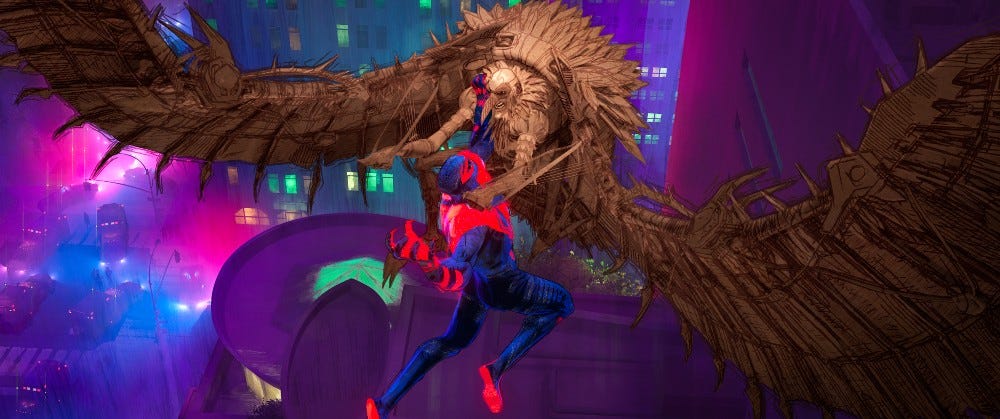SPIDER-MAN: ACROSS THE SPIDER-VERSE Review
"By the time the movie ends, you are left wanting more, so it’s good to know that there is indeed more on the way. "
I’m desperately trying to revive my weekly Weekend Warrior column, which is more about reviews than box office these days, but since the embargo for Sony’s animated sequel drops before I can possibly write up the rest of the week’s movies, you’re getting another separate stand-alone review for this one.
Now, don’t tell Dan Slott this, but I was never the biggest fan of the Spider-Verse in the comics. It started out as a cool and unique idea, but over the years, it’s just gotten a little out of control, as it’s been used as an excuse to convince readers they need to buy more comics. (Believe me, I do not.) And yet, the original Spider-Man: Into the Spider-Verse took some of those ideas and created quite a novel animated feature that was quite deserving of its Oscar.
The sequel begins with the Hailee Steinfeld-voiced Spider-Gwen (or Ghost Spider or Spider-Woman, whatever you want to call her), telling her own story before she encounters Miguel O’Hara and Jessica Drew (voiced by Oscar Isaac and Issa Rae), who invite her to join a special team of Spider-people for reasons we’ll discover later. We then return to Miles Morales (voiced by Shameik Moore), whose parents are meeting with Miles’ principal at his private school. Miles is nowhere to be found, since he’s facing a C-level super-villain called the Spot (voiced by Jason Schwartzman), who will play a much larger role in the overall plot.
That’s probably all you need to know, and I want to respect the request from producers Phil Lord and Chris Miller to not spoil any of the movie’s many surprises and cameos beyond what’s already out there in the world. For instance, maybe you already know that the cast is expanded with the likes of Spider-Punk (voiced by Daniel Kaluuya) and Spider-Man India (Karan Soni), and the portrayals of those two characters really sold me on them, despite never really getting into them from the comics. I wish I could say the same for Oscar Isaac’s Spider-Man 2099 who essentially becomes the villain of the movie as the Spot is nearly forgotten through much of the second half. Still, there are more than a few fun surprises and nods to other aspects of the Spider-verse.
For the most part, the main focus of the movie remains on Miles, that time being split with Gwen, who we learn much more about. The two real champs among the voice cast have to be Brian Tyree Henry and Luna Lauren Velez as Miles’ parents, who help maintain how important Miles’ family is to him as a character compared to many other superheroes.
If you liked the look of the original movie, you’re going to be equally blown away by what the filmmakers* do with the sequel, a similar case of every single frame and cel being a work-of-art in itself, something that plays into the idea of the Spider-Man comics having so many different looks from the various artists that have drawn them over the years. It does sometimes get a little nuts in terms of the quick-paced editing during the action sequences, but things do settle down from time to time to remind us of the characters. (*I do find it interesting that the sequel has three different directors than the first movie, although Lord and Miller co-wrote this one, as they did the original.)
It takes quite some time before we get to the actual plot, which involves the group of Spider-people we met earlier and others, and how the existence of the Spot, whose powers involve dimension-hopping, has been disrupting the Spider-Verse. It also deals with how Miles’ attempts to save people, who contribute to the Spider-man canon that connects all of them together, ends up creating more chaos in his particular portion of the multiverse.
There are times when things get overly sentimental, and other times when there is so much going on, that few brains will be able to fully absorb and process everything being thrown at them. On the other hand, Daniel Pemberton’s score is superb in all regards, acting as a glue to hold the movie’s different tones together while adding to both the action and the emotion.
It’s probably a good idea going into Across the Spider-Verse knowing that it’s a two-part story, since it might upset those who forget that fact and are thrown off when the film ends with “To Be Continued…” Sure, there’s an argument to be made for condensing the storytelling into one shorter movie, but by the time the movie ends, you are left wanting more, and it’s good to know that there is indeed more on the way. Across the Spider-Verse proves to be a fruitful sequel, even if it’s not a complete one, but it also offers enough rewatch value for those that want to find all of the many Easter eggs hidden within.
Rating: 8/10
Spider-Man: Across the Spider-Verse will open nationwide on Friday, June 2 with previews starting as early as 2pm on Thursday.






